Dollar Draws Support from Claims of U.S.-China Progress but Data Deluge Looms
- Written by: James Skinner

Image © Adobe Images
- USD draws support from trade headlines but data deluge looms.
- White House says in “final throes” of talks over ‘phase one deal’.
- China acknowledges talks between Liu He, Mnuchin, Lighthizer.
- USD/JPY follows stocks higher, funding currency EUR languishes.
- GBP/USD treads water ahead of MRP poll as sellers lie in wait.
- U.S. data deluge looms, could see USD weaken in noon session.
The Dollar was higher against most rivals Wednesday as investors responded to fresh claims that a U.S.-China trade deal is near, although an economic data deluge could potentially weaken the greenback in the noon hours.
Negotiators are in the “final throes” of firming up the ‘phase one deal’ announced on October 11 by President Donald Trump and China’s Vice Premier Liu He, according White House was reported to have said late on Tuesday.
U.S. claims of progress were acknowledged by China’s Ministry of Commerce, which noted that Vice Premier Liu He had spoken by telephone with Treasury Secretary Steven Mnuchin and Trade Representative Robert Lighthizer on Tuesday. China said they “discussed how to resolve each other’s core concerns and reached consensus on how to resolve related issues.”
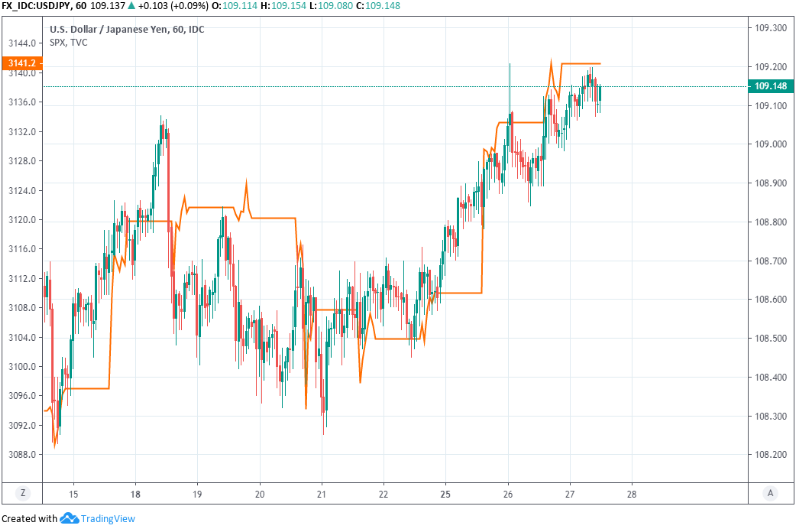
Above: USD/JPY rate shown at hourly intervals alongside S&P 500 stock market index.
The two sides are working against the clock because new U.S. tariffs are scheduled to hit imports from China on December 15 unless the White House decides otherwise. The deal is thought to have been held up by differences over how many of the tariffs from the last 18 months should be removed.
“I'll try and keep my inner cynic at bay. Still, if the sign of an excellent economy is a rising stock market, then all is well in S&P-land. Equities rising, bond yields in a range and the dollar steady, at very elevated levels,” says Kit Juckes, chief FX strategist at Societe Generale. “USD/JPY is back testing the top of its range, and EUR/USD is threatening to break lower...we want to go on buying the dip in the bond market and go on selling rallies in China-sensitive currencies.”
White House claims of progress are not new and have often been met with silence from Beijing so Wednesday’s price action could be explained by the fact that such claims were mutual this time. However, it remains to be seen if the Dollar will retain the initiative through the rest of the session, not least of all because of a data deluge expected in the noon hours.
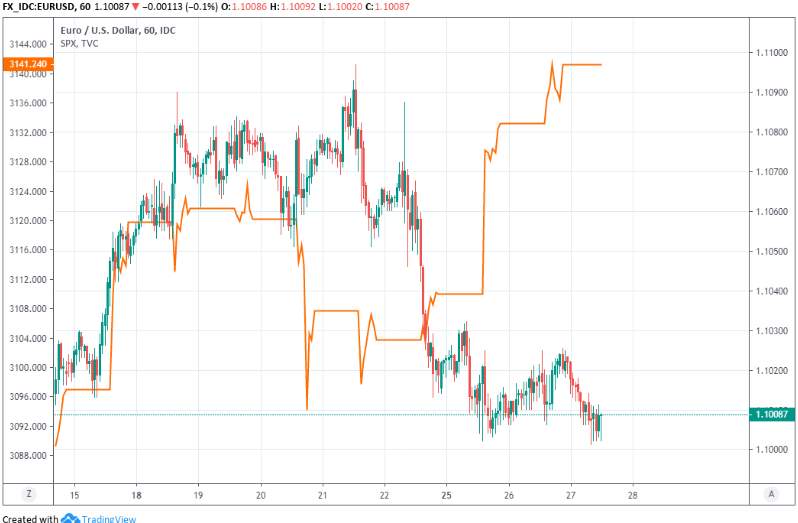
Above: Euro-to-Dollar rate shown at hourly intervals alongside S&P 500 stock market index.
The USD/JPY rate was following stock market futures higher early in the Wednesday session while the Euro-to-Dollar rate was languishing near its range-lows. Meanwhile, the greenback ceded ground to a Pound that was trading buoyantly ahead of a key pre-election opinion poll.
USD/JPY and EUR/USD flows account for more than 60% of the Dollar index so it only takes the former to rise and the latter to fall in order to produce an upturn in the broad greenback, although the U.S. currency was up against more than just the Yen and Euro Wednesday.
Safe-havens like the Yen are bound to remain underperformers the entire time that investors’ risk appetites are robust and stock markets are rising while the Euro’s bottom-of-the-class economic position has left it liable to underperform even in the good times. Europe’s unified unit is often now described by analysts as a ‘funding currency’ because of its low interest rates, which sees investors borrow Euros only to immediately sell them in exchange for better things further afield - like emerging market currencies.
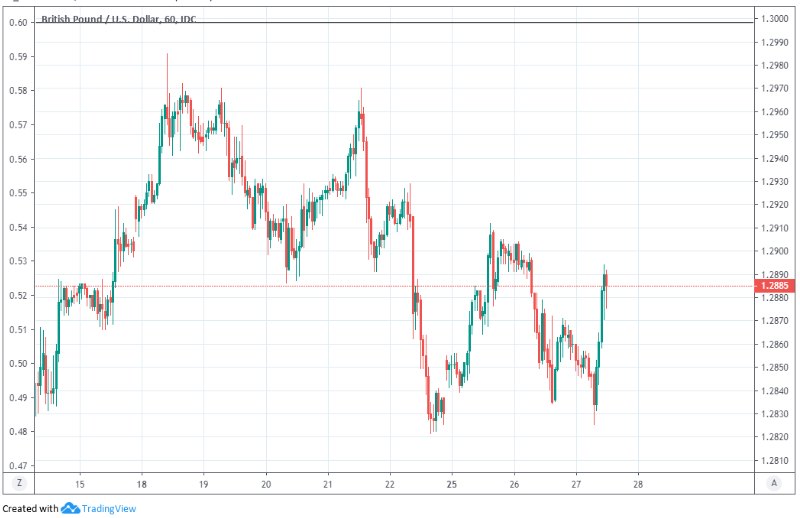
Above: Pound-to-Dollar rate shown at hourly intervals.
“GBP/USD continues to range trade between its October high at 1.3013 and the current November low at 1.2768,” says Karen Jones, head of technical analysis at Commerzbank. “Failure at 1.2768 would probably see a slide to the 200 day ma at 1.2701. This guards the 1.2582 September high.”
Jones, who studies trends and momentum on the charts rather than macroeconomic fundamentals, told clients Wednesday to sell the Pound-Dollar rate if it recovers to the 1.2950 level and to target a move down to 1.2525 in the weeks ahead. Her outlook lends technical support to view advocated by analysts at MUFG, who’ve been looking for pre-election dynamics to push the exchange rate down to 1.26 ahead of the December 12 ballot.
Pre-election dynamics were again at work on Wednesday with the British currency treading water ahead of the 22:00 release of YouGov polling data that includes ‘MRP’ projections of public support for the main parties and how that will translate into parliamentary seats. Most polls have so far focused mostly on the popular vote and have used rules of thumb to estimate implied numbers of seats but the Yougov methodology on seat numbers is a bit more scientific.
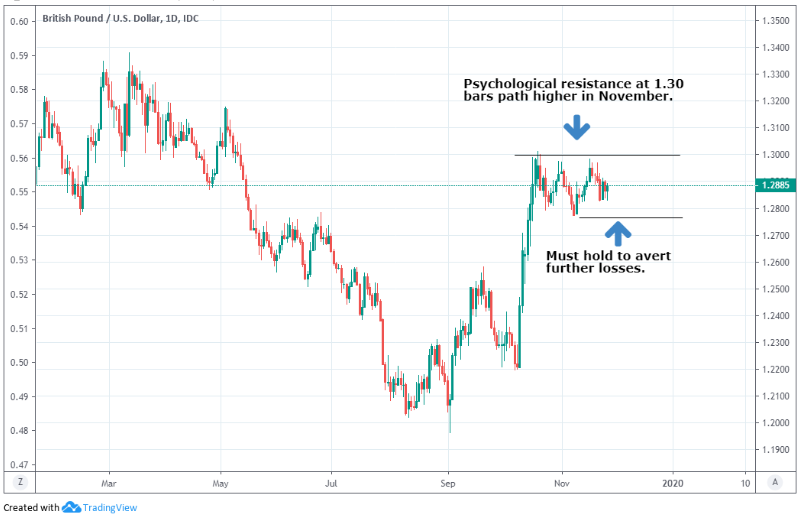
Above: Pound-to-Dollar rate shown at daily intervals and annotated with Commerzbank support and resistance levels.
“USD can retrace some of its overnight gains today on soft US business investment and inflation dynamics,” says Elias Haddad, a strategist at Commonwealth Bank of Australia. “Consensus expectation is for US core capital goods orders (non‑defence, excluding aircraft), a good leading indicator of business investment, to fall for a third consecutive month in October (8:30am New York). Meanwhile, the policy‑relevant core PCE deflator is estimated to stay muted under 2% in October (consensus: 1.7%/yr, CBA: 1.8%/yr).”
Price action was driven by trade headlines in the morning hours but a U.S. data deluge will be the main driver of bids and offers in the noon session because itll bring the Federal Reserve (Fed) back into focus for investors.
Arguably, the PCE Price Index and Chicago PMI are the headline events in the U.S. calendar for Wednesday, although core-durable goods orders figures and the second estimate of third quarter GDP growth will also garner a quick look from the market. Core-durable orders, an important part of the business investment component of GDP, are expected to have risen 0.2% in October when the data is released at 13:30 while the third-quarter growth number is seen unrevised at an annualised 1.9%.
“The average core PCE reading for the US this century is just 1.72%, so if the Fed is serious about its target being symmetric, it should be concerned if the string of 1.7s grows. We believe the Fed wants to see where inflation YoYs land when the Nov-Dec oil price crash is in the base period before dropping hints about any further rate cuts. However, USDJPY might not be that patient. We are bullish USDJPY through year's end due to seasonals, but we wouldn't want to be long the pair for this PCE print,” says Stephen Gallo, European head of FX strategy at BMO Capital Markets.
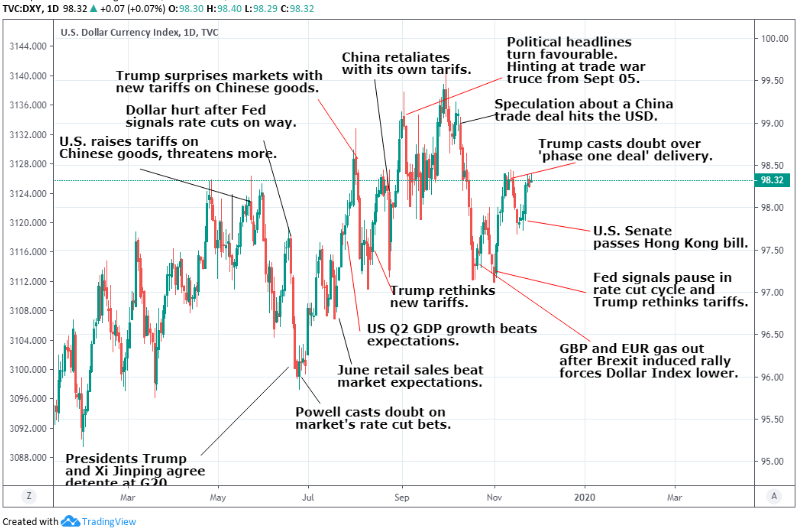
Above: Dollar Index shown at daily intervals and annotated for recent events.
Markets will scrutinise the PCE Price Index for clues on the extent to which inflation pressures will tie the hands of the Federal Reserve in the months ahead, while taking hints from the Chicago PMI on the likely state of the U.S. economy in November. The PMI is a leading indicator of economic economic activity in the third largest U.S. city in terms of GDP. It’s expected to rise from 43.2 to 47.2 upon publication at 14:45. Consensus is looking for the core PCE price index to have risen 0.2% in October when it’s released at 15:00. The annualised rate was 1.3% in September.
Anything suggesting slower growth or lesser inflation pressures ahead could be enough to get investors betting more heavily on additional rate cuts next year from the Fed, which has already cut rates three times in 2019. Chairman Jerome Powell, as well as other policymakers, has recently said the economy and interest rate settings are “in a good place” and that it would take a “material reassessment” of the outlook to change that view.
“The complacency melt-up continues in equity markets and continues to see muted volatility in FX, though the USD has edged to resistance in many places and will have a hard time not reacting to incoming data if it surprises today,” says John Hardy, chief FX strategist at Saxo Bank. “USDJPY has turned back higher again as it is tough for the yen to catch any kind of bid in a massive global equity market melt-up. The move has the pair joining EURUSD and AUDUSD in trading near a key USD resistance point. It’s tough to know how much this very quiet market will hang its hat on data points today ahead of the big US holiday weekend (yes markets are open half a day on Friday in the US, but most have the rest of the week off starting today.) but USDJPY is historically quite reactive to US data.”
Time to move your money? Get 3-5% more currency than your bank would offer by using the services of a foreign exchange specialist. A specialist payments provider can deliver you an exchange rate closer to the real market rate than your bank would, thereby saving you substantial quantities of currency. Find out more here.
* Advertisement




